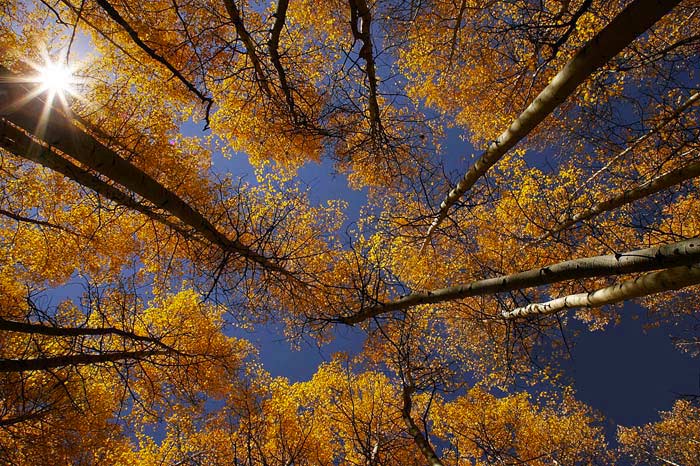
© 2010 Andy Long. All rights reserved.
Aspen trees, or any trees for that matter, can be captured in a couple of ways. You can look around for a good spot and use the tree shadows to set up a sun star or lay on the ground and position the image as you want.
As the temperatures start to dip, photographers’ imaginations tend to wander off in a couple different directions. One follows the elk rut that occurs throughout the western part of the country. Another can be found at a variety of spots in the east, north, and west where a palate of peak fall colors spreads across the hillsides. Several quintessential images come to mind: almost any photo of Maroon Lake with the Maroon Bells in the background; a photo made while you’re lying on the ground shooting up into a blue sky bracketed by colorful leaves and tree trunks; close-ups of backlit leaves; a close-up photo of a mix of colors (such as reds, yellows, and rust); and an image created in Grand Teton National Park from Oxbow Bend with the Teton Range in the background. All of these are great to have in a library of images, but looking for something to stand out from the everyday favorites is where the fun of autumn color photography comes into play. Fog, storm clouds, and snow can add interesting files to your collection.
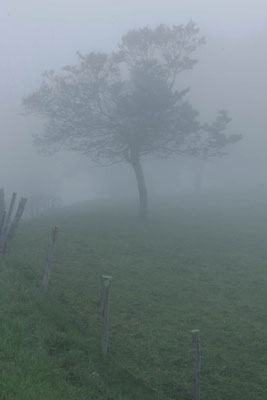
© 2010 Andy Long. All rights reserved.
Let fog work to your advantage. Here it helps to isolate a lone tree.
Fall is a great season for finding fog. The difference in temperatures between the ground and air makes it a common occurrence. Getting above the fog on a ridge or mountaintop gives you a clear view of the area with fog nestled in a series of mountain ridges or along a river. Even if the river can’t be seen, the fog that fills the area draws the viewer’s eye–maybe better than the river itself would.
While fog around a group of trees is nice, finding an isolated tree set apart from others creates a very strong image. One of Ansel Adams’ top prints is of an oak tree shrouded in fog with low sun coming through in the background. The thicker the fog for this type of photo the better, as it helps obscure whatever else is in the viewfinder and puts all the emphasis on the main subject. Whether the leaves have fallen off the tree or not is not important as long as the detail of the tree can be seen.
Metering fog can either enhance or diminish the effect of the final image. If you’re above the fog and it’s bright white, treat it as snow and open up about a stop to balance the color. If you’re photographing through the fog, underexpose about –2/3 of a stop to darken the overall image and bring out the fog even more or go +1/3 to lighten it up a bit. Don’t rely on your digital LCD screen for reviewing the shot, though, as it tends to brighten things up. Typically, you hear advice to overexpose for a scene with fog, as fog tends to be lighter in color than a clear day. However, sometimes you want to portray a different effect. This is where bracketing comes in. Make several images on the plus side, but don’t think underexposing is out of the question, because it can deepen the mood. While the LCD might not provide the best view, the histogram can be useful in showing if your highlights are blown-out.
Another natural element that can be great for adding to a fall photo trip is storm clouds. The darker, more ominous and threatening the sky, the more drama and mood in the resulting images. An average dreary day won’t work; the weather has to be on the verge of a big storm. As in fog, using exposure compensation on the minus side will make the clouds appear darker than they really were. To lessen the effect, go to the plus side, again bracketing to get the exact feel you want. Take a spot meter on the sky and then on the hillside. Split the difference, if there is any, or lean to the side desired to emphasize either the sky or the hillside.
When storm clouds are brewing, the effect is enhanced if the storm is on the opposite horizon from the sun. While the sun is obscured, you might not have the greatest of photos, but if the sun breaks through and shines on a hillside blanketed with fall color as storm clouds gather above, a very dramatic image results. The contrast between the mood of the dark sky and the reds or yellows mixed with green on the hillside draws the viewer into the scene. Depending upon the sky, a couple of composition options are available. If the sky is quite dramatic with good definition in the clouds, about two-thirds sky and one-third hillside would enhance the feel of the storm. Going the other way would work if there’s good light on the hillside or the sky isn’t overly dramatic. In contrast to bracketing by exposure for fog, bracketing by composition would be a good choice when you’re confronted with this situation.
There may be times when you’re out photographing fall color when you’re treated to an early snowfall. This added bonus opens up more opportunities. A dusting of snow on the mountains and ground adds different contrast to the image than the typical leaves and sky. A hillside of mixed color can have added impact if some of the trees are snow-covered and others with color are popping out.
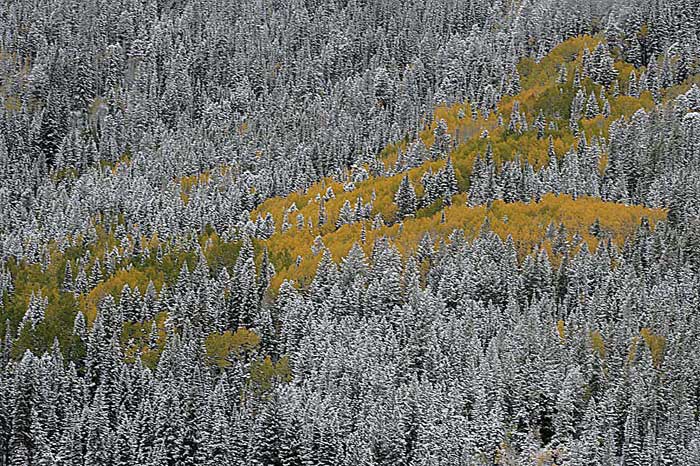
© 2010 Andy Long. All rights reserved.
The Aspens come alive when they’re surrounded by snow covered pines.
Looking at small, intricate portions of the whole can be another approach—especially when snow is present. A group of tree trunks with a coating of snow on their branches can create good patterns. A hint of color in the background affirms that the photo was made during fall color. Tight photographs through the trees can also produce interesting images. The contrasting trunks and leaf colors offer potential for scenes concentrating on color, patterns, and depth. The leaves in the background of the trunks can be handled either with a shallow depth-of-field where they are in soft focus or with lots of depth-of field where everything is sharp.
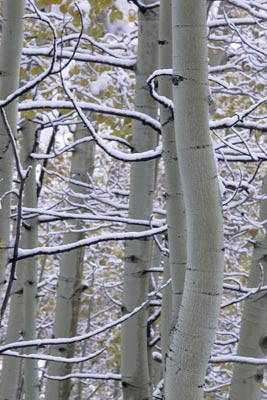
© 2010 Andy Long. All rights reserved.
Fresh snow on branches can help bring out the patterns of the trees.
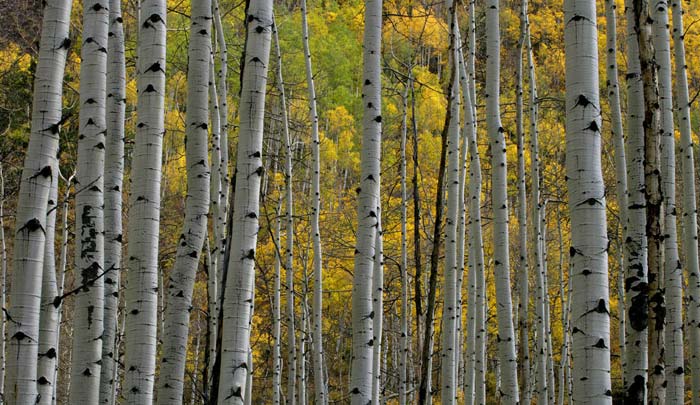
© 2010 Andy Long. All rights reserved.
While isolating the color through the trees you can either use a lot of depth to get nice detail or shallow depth to soften it up a bit.
Another good subject to look for is a hillside where there is one tree that is significantly different within a group of other trees. There are instances where the odd single tree with leaves changing can be among some evergreens or the other way around with one green tree isolated in a sea color. (This isn’t something that is common, so if you find this situation, take advantage of it.) Fences, barns, old cabins, and other structures make for great scenes, too. Any one of these in the foreground with color around and behind it creates a feeling of place. The older the structure is, the better the essence of the photo. Fences can be used as a lead-in line to take the viewer back to either a single tree or a vast field of view.
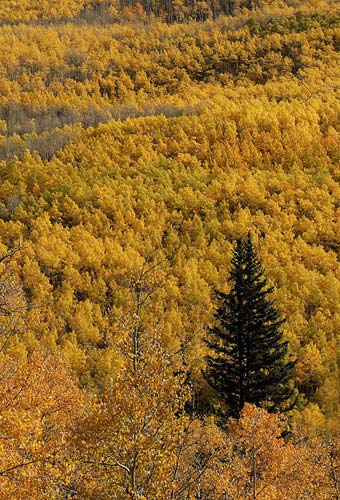
© 2010 Andy Long. All rights reserved.
Contrast in color and texture will draw the viewer’s attention.
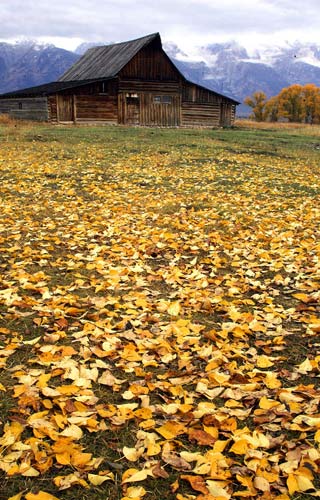
© 2010 Andy Long. All rights reserved.
Fallen blankets of leaves can create a path to your main subject, such as this old barn on Mormon Row in the Grand Tetons.
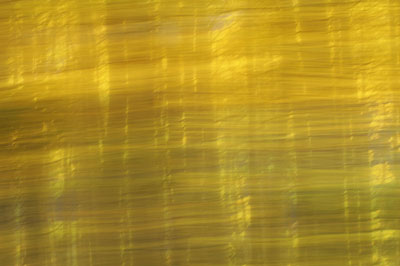
© 2010 Andy Long. All rights reserved.
If you stop panning on a long exposure before the shutter stops, it will blur the leaves but freeze the tree trunks in the photo.
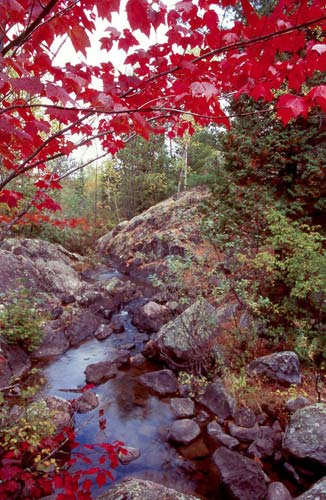
© 2010 Andy Long. All rights reserved.
Using bold color to frame a scene can pull the viewer’s eye into the setting.
Have you ever arrived on scene to make your fall images only to discover a lot of the leaves are already on the ground or may not have changed colors just yet? These situations are recoverable. If you can find trees that still wear color, combine small sections of them for an image with a mix of trees with leaves and some without. Or let the bold colors of one that has changed color be in contrast to those that have not.
Be creative when you seek fall color scenes. You don’t always have to capture the entire canvas that is laid out before you. Take some time to view your surrounding. See if you can isolate bits and pieces in order to pull your viewer into the setting.
by Andy Long
First Light Photo Workshops
All text & photos: © 2010 Andy Long. All rights reserved.

Leave a Reply